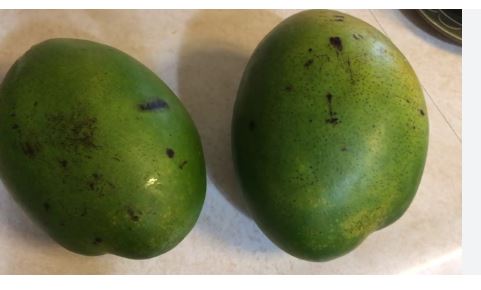
Keitt mangoes are classified as Mangifera indica, a species within the Anacardiaceae family, which also includes cashews, pistachios, and poison sumac. The genus Mangifera encompasses around 35-40 species of tropical fruiting trees, with M. indica being the primary cultivated species, boasting hundreds of cultivars worldwide. Keitt is a monoembryonic variety, meaning its seed produces a single shoot, unlike polyembryonic types common in Southeast Asia. Developed through selective breeding rather than occurring as a wild species, it reflects the extensive diversity within this globally cherished fruit tree.
Keitt mangoes originated in 1939 in Homestead, Florida, when Mrs. J.N. Keitt discovered a promising seedling on her property. Believed to be a chance seedling of the Mulgoba mango—an Indian cultivar introduced to Florida in the late 19th century—it was propagated in 1945 and named after its finder by the early 1950s. The Keitt family nurtured its development, and it gained prominence in Florida’s mango industry for its late-season ripening and shipping durability. By the 1970s, it became a commercial staple in the U.S., prized for its size and extended harvest window. Today, Keitt is grown widely in Florida, California, Hawaii, Mexico, and parts of Australia and South Africa, valued for its reliability and market appeal.
Keitt mangoes are notably large, often weighing 1-3 pounds, with an oval-to-oblong shape that can reach 6-8 inches in length. Their thick, smooth skin remains predominantly green even when ripe, though it may develop a faint yellow or pink blush near the stem, making ripeness harder to judge by color alone (a slight give indicates readiness). The flesh is a deep orange-yellow, firm, and juicy, with minimal fiber—among the least fibrous of mangoes—surrounding a single, flat, monoembryonic seed. Ripening from August to October in Florida, it’s a late-season cultivar, often the last mango harvested. The taste is rich and sweet, with a mild tartness and a smooth, creamy texture, offering subtle citrus and peach notes, though less aromatic than some Indian varieties.
Mangifera indica ‘Keitt’ thrives in USDA zones 10-11, excelling in frost-free, tropical to subtropical climates with temperatures ideally between 70-95°F (21-35°C). It can withstand brief dips to 30°F (-1°C), but prolonged cold below this harms or kills the tree, restricting its U.S. range to southern Florida, coastal California, Hawaii, and Puerto Rico. In zones 9b-10, it can be grown with protection (e.g., greenhouses or frost cloths) if started indoors and shielded from winter chill, though fruiting may be inconsistent. It requires full sun (6-8 hours daily) and well-drained, sandy loam soil (pH 5.5-7.5), performing best in humid regions with 30-100 inches of annual rainfall or irrigation.
Culinary Applications
- Fresh Eating: Their firm, juicy, low-fiber flesh offers a sweet, smooth bite, perfect for peeling and enjoying raw.
- Salads: Diced or sliced, they add a rich, sweet-tart flavor to fruit or green salads, pairing well with avocado or mint.
- Smoothies: Blended with ice or yogurt, they create creamy, refreshing drinks with a subtle citrus-peach note.
- Salsas: Chopped with jalapeño, lime, and cilantro, they make a vibrant salsa, balancing heat with sweetness for seafood or chips.
- Desserts: Pureed for sorbets, mousses, or cakes, their velvety texture enhances sweets with minimal added sugar.
- Chutneys: Simmered with spices and vinegar, they form a tangy-sweet condiment, ideal for curries or grilled meats.
- Juicing: Pressed into juice, they yield a thick, sweet drink, great alone or mixed with pineapple for a tropical blend.
- Grilling: Sliced and grilled, they caramelize lightly, adding a juicy, sweet contrast to savory dishes like chicken or pork.
Cultivation of Keitt Mangoes
- Climate: Keitt thrives in warm, tropical to subtropical climates with temperatures between 70-95°F (21-35°C) and high humidity. It requires frost-free conditions to flourish and fruit reliably.
- USDA Zones: Best suited to USDA zones 10-11, where temperatures stay above 30°F (-1°C). In zone 9b, it can be grown with frost protection (e.g., greenhouses or covers), but cold limits fruiting success.
- Soil: Needs well-drained, sandy loam soil with a pH of 5.5-7.5, enriched with organic matter. It tolerates poorer soils but dislikes waterlogging, which damages its shallow, fibrous roots.
- Sunlight: Demands full sun (6-8 hours daily) for vigorous growth, flowering, and large fruit development. Shade reduces yield and fruit quality significantly.
- Planting: Propagated via grafting onto rootstocks like Turpentine or Number 11 for vigor and disease resistance, ensuring true-to-type fruit (seeds don’t breed true). Space trees 25-35 feet apart, planted in spring post-frost.
- Watering: Requires consistent moisture—1-2 inches weekly—during establishment, flowering (late winter), and fruit growth (summer). Reduce water post-harvest to induce dormancy; overwatering risks root rot.
- Support: Young trees may need staking for 1-2 years against wind due to shallow roots and heavy fruit. Mature trees (20-40 feet tall) are sturdy but benefit from pruning for shape and harvest ease.
- Pollination: Monoecious flowers (male and hermaphrodite) bloom late winter to spring, self-pollinating but enhanced by cross-pollination via bees or flies. Nearby mangoes (e.g., Tommy Atkins) or hand-pollination improve fruit set.
- Pests: Vulnerable to mango seed weevils, fruit flies, and scale insects. Use traps, neem oil, or fruit bags; remove fallen fruit and encourage predators like parasitic wasps to manage infestations.
- Diseases: Susceptible to anthracnose, powdery mildew, and bacterial black spot. Apply copper fungicides pre-bloom, prune for airflow, and avoid overhead watering—Keitt has moderate disease tolerance.
- Harvest: Fruits ripen late season (August-October in Florida), picked when green with a slight give (not by color). Harvest with clippers, leaving a short stem; mature trees yield 50-200 lbs annually, depending on care.
- Yield: Begins fruiting 3-5 years after grafting, peaking at 7-15 years with 100-300 mangoes per tree under optimal conditions. Prune lightly post-harvest to remove dead wood and promote next season’s flowering; lifespan can exceed 50 years.